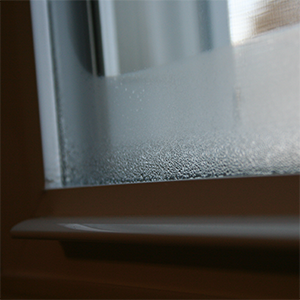 Understanding common household condensation:
Understanding common household condensation:
Common household condensation or “sweating” on windows is created by excess humidity or water vapor in a home. When water vapor in the air comes in contact with a cold surface such as a mirror or glass window, it turns into water droplets called condensation. All homes have occasional condensation, such as a little fogging on the windows, but this is no cause for concern.
On the other hand, excessive window condensation, frost, peeling paint, even moisture spots on ceilings and walls can be signs of excessive condensation and potentially damaging problems in your home. We tend to notice condensation on windows and mirrors first because moisture doesn’t penetrate these surfaces. Yet they are not the problem, simply indicators that you need to reduce the indoor humidity of your home.
Conquering The Myth- Windows DO NOT cause condensation:
You may be wondering why your new energy-efficient windows show more condensation than your old drafty ones. It’s simple- your old drafty windows were not airtight and allowed humidity to escape. Now that your new windows create a tighter seal, the extra moisture in your home is unable to escape, therefor making you more aware of excess humidity. Windows DO NOT cause condensation; instead they prevent humidity from escaping and provide an easy surface for condensation to collect.
Sources of humidity:
All air contains a certain amount of moisture, even indoors. Indoor humidity is generated by many household items and activities, such as your heating system, humidifiers, cooking and showers. In fact, every activity that involves water, even mopping the floors, contributes to air moisture.
Climate can also contribute to condensation. Condensation is more likely to occur in homes where January temperatures drop below 35⁰F because there are greater temperature extremes affecting the glass in the home.
It is typical to experience condensation at the start of each heating season. During the humid summer months your home absorbs moisture and then perspires when you turn on the heat. This is only temporary though; after the first few weeks of heating your home should dry out- reducing, if not eliminating, condensation.
Another factor in the condensation heating equation is progress. With today’s high-performance insulation, moisture-barrier materials and airtight construction, we all enjoy a more thermally efficient home- one that blocks the cold air out, yet traps the moisture in, producing higher humidity levels and more condensation.
Reducing humidity in your home:
The best way to reduce condensation is by eliminating excessive humidity. The following table illustrates the recommended or comfortable levels of indoor humidity during the winter months.
| OUTSIDE TEMPERATURE | INSIDE RELATIVE HUMIDITY |
| -20⁰F | 15% - 20% |
| -10⁰F | 15% - 20% |
| 0⁰F | 20% - 25% |
| 10⁰F | 25% - 30% |
| 20⁰F | 30% - 35% |
(Indoor humidity can be measured with a humidistat or psychrometer)
By eliminating excessive humidity in your home, you may very well eliminate most, if not all, of your condensation problems.
Six ways to control indoor humidity:
- Make sure all sources of ventilation to the outside are functional, and use kitchen, bathroom and laundry room exhaust fans during and after humidity-producing activities to vent excess moisture.
- Air out your home periodically. Opening windows for just a few minutes a day lets the stale, moist air escape and the fresh, dry air enter without compromising your heating.
- Check your humidifier settings. Use the humidity comfort levels provided in the table to correctly set and balance the humidity in your home.
- Be sure that all louvers in the attic or basement are open and large enough. You can even open your fireplace dampers to allow excess moisture to escape.
- If you have a large amount of houseplants, try to concentrate them in one area and avoid over-watering.
- If troublesome condensation persists, see your heating contractor about an outside air intake for your furnace, venting of gas burning heaters and appliances, or installation of venting fans.
Resolving condensation problems:
Condensation can be very difficult to control. There are many factors that affect condensation, such as the number and type of windows in your home, the heating system, the type of insulation and vapor barrier and even the type of soil and quality of drainage. If you still have condensation problems after following the simple preventative steps mentioned above, you may need to consult a professional heating contractor or qualified expert.
